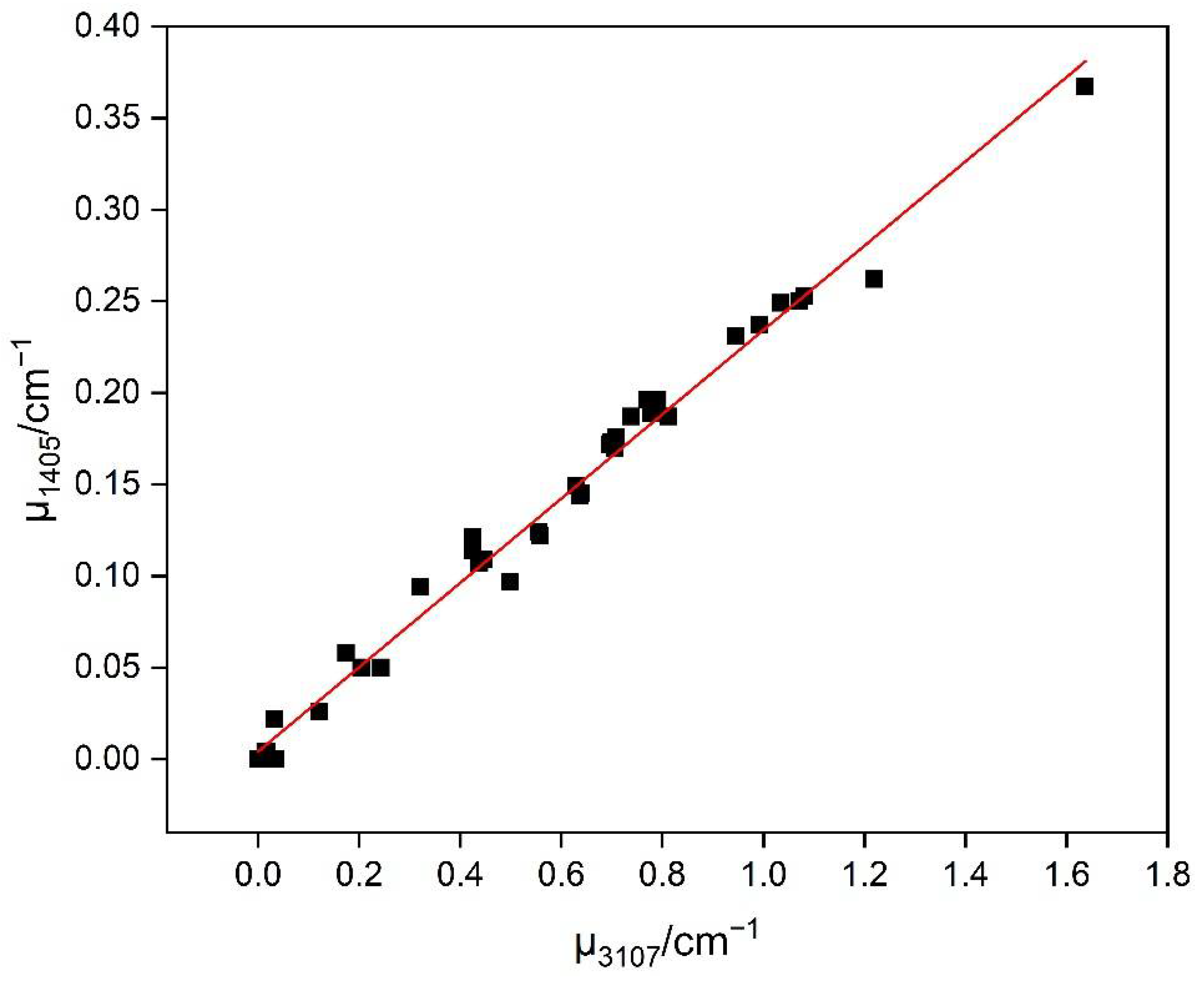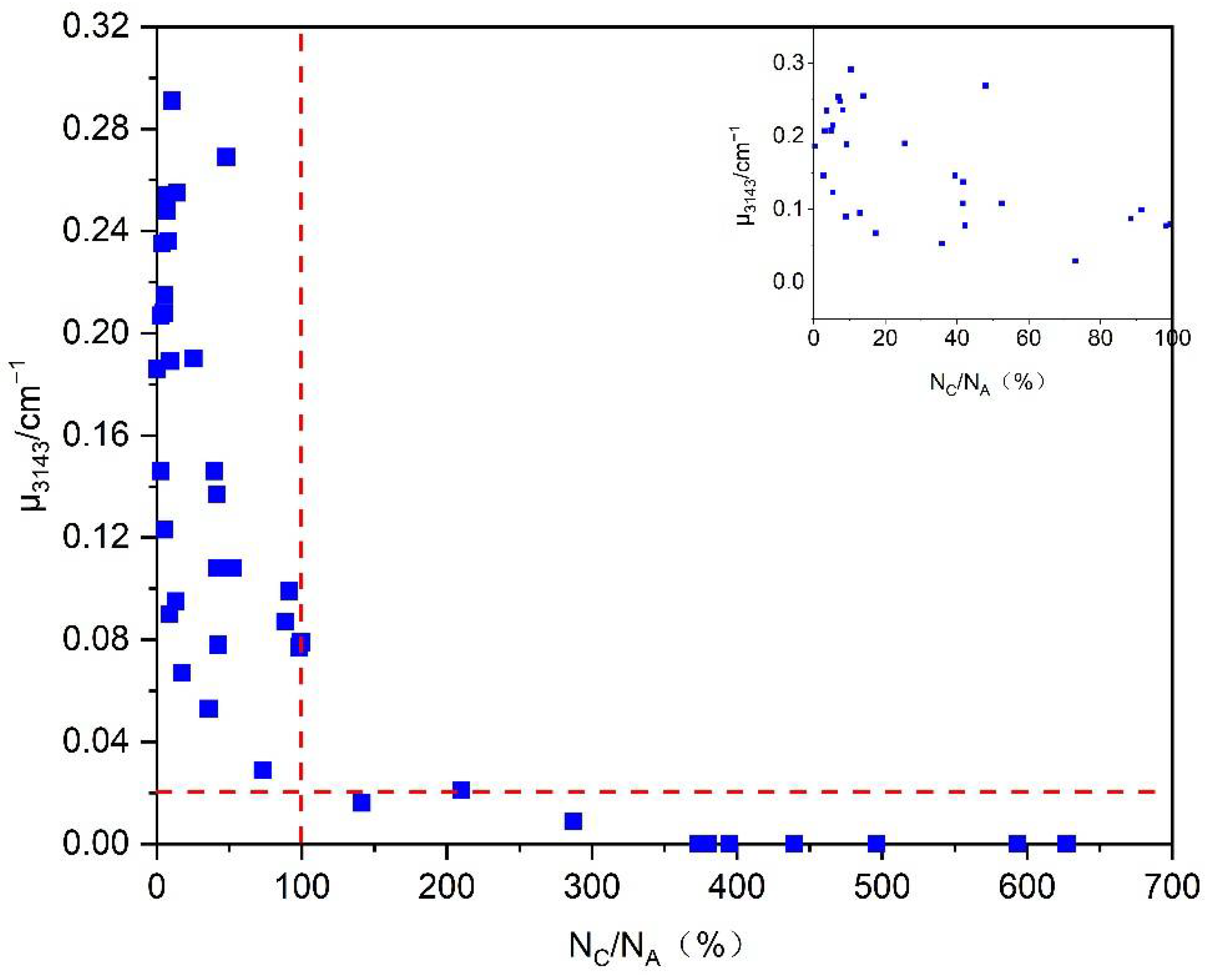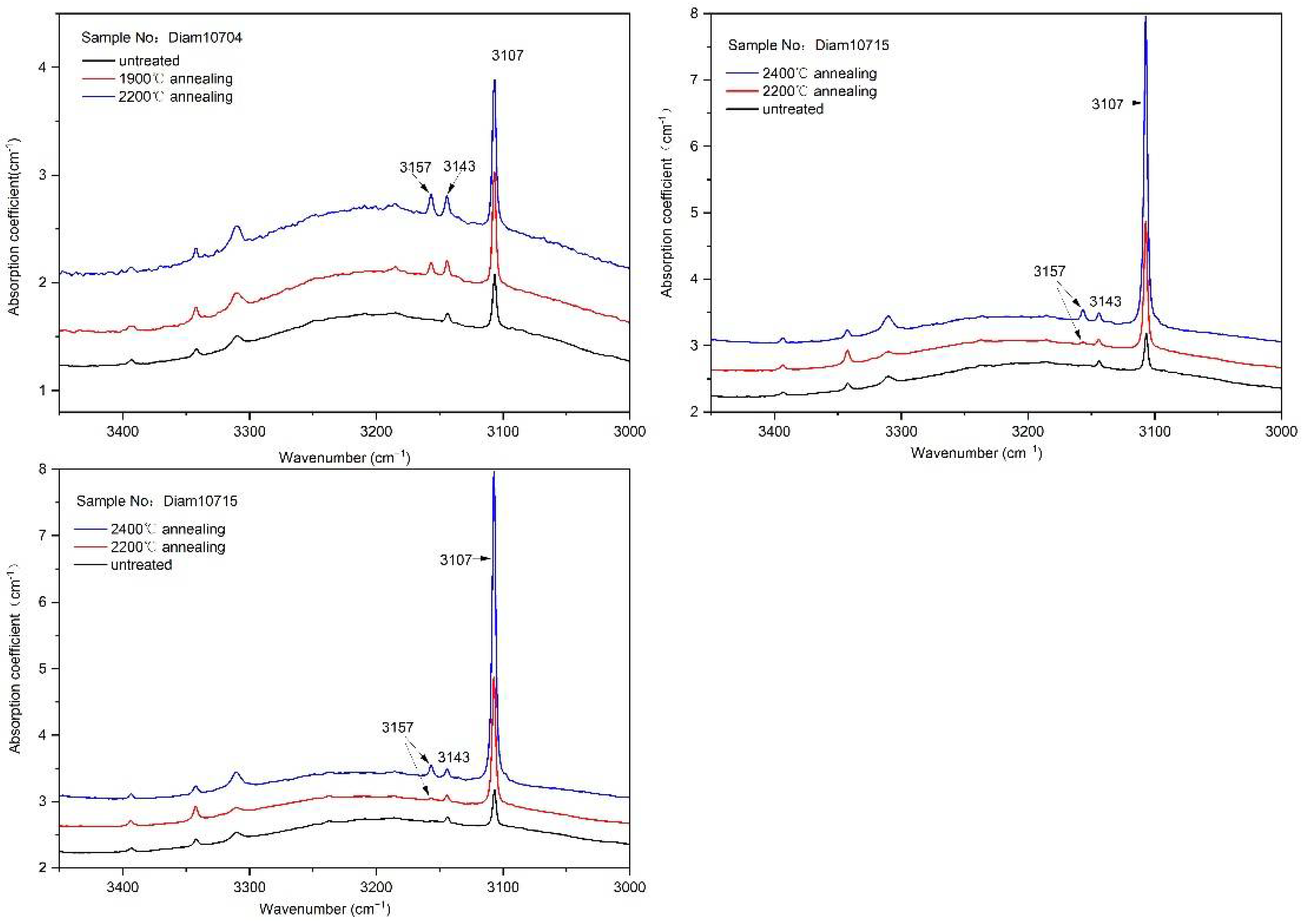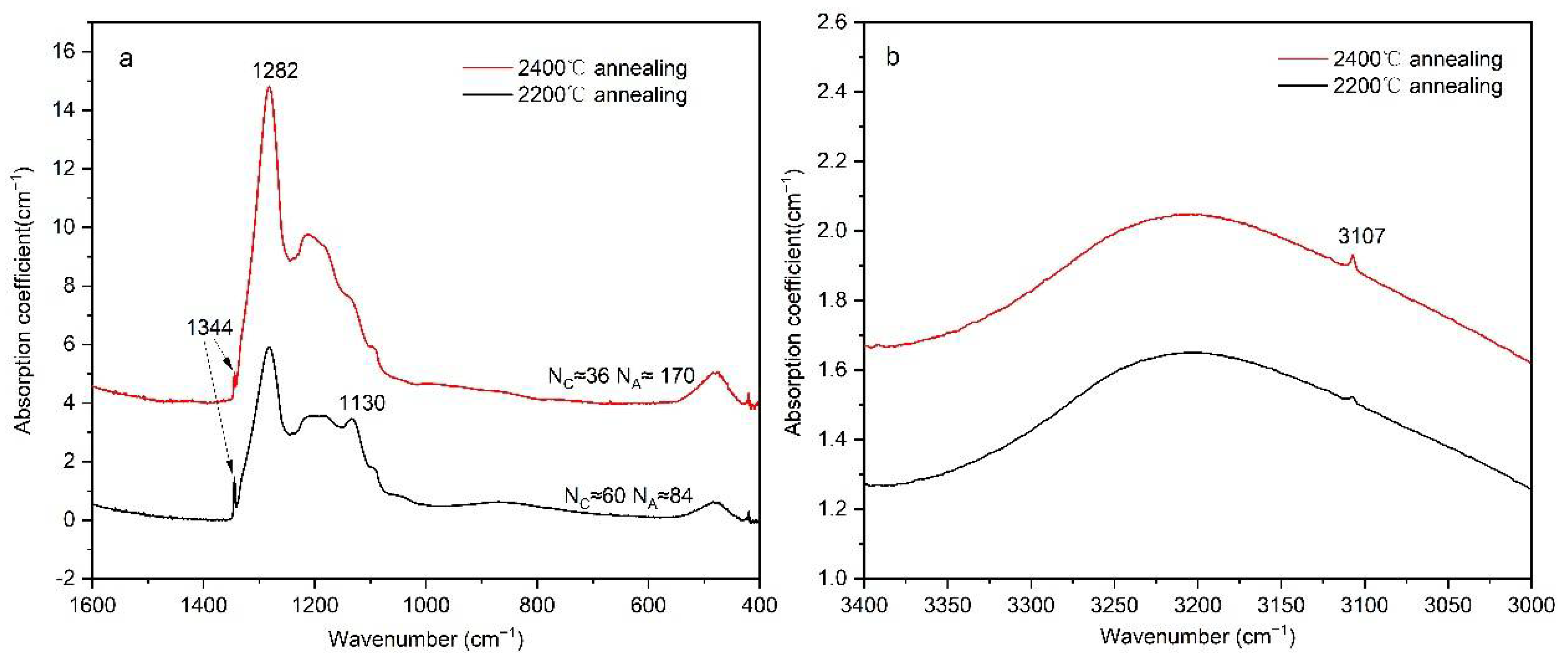Spectroscopic Study of the 3107 cm−1 and 3143 cm−1 H-Related Defects in Type Ib Diamonds
Abstract
:1. Introduction
2. Materials and Methods
3. Results and Discussion
3.1. Hydrogen-Related Defects in Ib Natural Diamond
3.2. Hydrogen-Related Defects in HPHT-Treated Type Ib Natural Diamonds
3.3. Hydrogen-Related Defects in HPHT-Treated Type Ib Synthetic Diamonds
4. Conclusions
Supplementary Materials
Author Contributions
Funding
Data Availability Statement
Acknowledgments
Conflicts of Interest
References
- Collins, A.T. The colour of diamond and how it may be changed. J. Gemmol. 2001, 27, 341–359. [Google Scholar] [CrossRef]
- Sideras-Haddad, E.; Connell, S.H.; Sellschop, J.; Machi, I.Z.; Rebuli, D.; Maclear, R.D.; Doyle, B.P. Hydrogen and oxygen chemistry and dynamics in diamond studied by nuclear microscopic techniques. Nucl. Instrum. Methods Phys. Res. Sect. B 2001, 181, 419–425. [Google Scholar] [CrossRef]
- Khan, R.U.; Martineau, P.M.; Cann, B.L.; Newton, M.E.; Twitchen, D.J. Charge transfer effects, thermo and photochromism in single crystal CVD synthetic diamond. J. Phys. Condens. Matter 2009, 21, 364214. [Google Scholar] [CrossRef] [PubMed]
- Glover, C.; Newton, M.E.; Martineau, P.M.; Quinn, S.; Twitchen, D.J. Hydrogen incorporation in diamond: The vacancy-hydrogen complex. Phys. Rev. Lett. 2004, 92, 135502. [Google Scholar] [CrossRef] [PubMed]
- Shaw, M.J.; Briddon, P.R.; Goss, J.P.; Rayson, M.J.; Kerridge, A.; Harker, A.H.; Stoneham, A.M. Importance of quantum tunneling in vacancy-hydrogen complexes in diamond. Phys. Rev. Lett. 2005, 95, 105502. [Google Scholar] [CrossRef] [PubMed]
- Fritsch, E.; Hainschwang, T.; Massi, L.; Rondeau, B. Hydrogen-related optical centers in natural diamond: An update. New Diam. Front. Carbon Technol. 2007, 17, 63–89. [Google Scholar]
- Woods, G.S.; Collins, A.T. Infrared absorption spectra of hydrogen complexes in type I diamonds. J. Phys. Chem. Solids. 1983, 44, 471–475. [Google Scholar] [CrossRef]
- Goss, J.P.; Briddon, P.R.; Hill, V.; Jones, R.; Rayson, M.J. Identification of the structure of the 3107 cm-1 H-related defect in diamond. J. Phys. Condens. Matter 2014, 26, 145801. [Google Scholar] [CrossRef]
- Fuchs, F.; Wild, C.; Schwarz, K.; Müller-Sebert, W.; Koidl, P. Hydrogen induced vibrational and electronic transitions in chemical vapor deposited diamond, identified by isotopic substitution. Appl. Phys. Lett. 1995, 66, 177–179. [Google Scholar] [CrossRef]
- Kiflawi, I.; Fisher, D.; Kanda, H.; Sittas, G. The creation of the 3107 cm-1 hydrogen absorption peak in synthetic diamond single crystals. Diamond Relat. Mater. 1996, 5, 1516–1518. [Google Scholar] [CrossRef]
- Weerdt, F.D.; Collins, A.T. Optical study of the annealing behaviour of the 3107 cm−1 defect in natural diamonds. Diamond Relat. Mater. 2006, 15, 593–596. [Google Scholar] [CrossRef]
- Charles, S.J.; Butler, J.E.; Feygelson, B.N.; Newton, M.E.; Carroll, D.L.; Steeds, J.W.; Darwish, H.; Yan, C.S.; Mao, H.K.; Hemley, R.J. Characterization of nitrogen doped chemical vapor deposited single crystal diamond before and after high pressure, high temperature annealing. Phys. Status Solidi A 2004, 201, 2473–2485. [Google Scholar] [CrossRef]
- Lai, M.Y.; Breeding, C.M.; Stachel, T.; Stern, R.A. Spectroscopic features of natural and HPHT-treated yellow diamonds. Diamond Relat. Mater. 2020, 101, 107642. [Google Scholar] [CrossRef]
- Kiflawi, I.; Mayer, A.E.; Spear, P.M.; Van Wyk, J.A.; Woods, G.S. Infrared absorption by the single nitrogen and a defect centres in diamond. Philos. Mag. B 1994, 69, 1141–1147. [Google Scholar] [CrossRef]
- Boyd, S.R.; Kiflawi, I.; Woods, G.S. The relationship between infrared absorption and the A defect concentration in diamond. Philos. Mag. B 1994, 69, 1149–1153. [Google Scholar] [CrossRef]
- Lawson, S.C.; Fisher, D.; Hunt, D.C.; Newton, M.E. On the existence of positively charged single-substitutional nitrogen in diamond. J. Phys. Condens. Matter 1998, 10, 6171–6180. [Google Scholar] [CrossRef]
- Hainschwang, T.; Fritsch, E.; Notari, F.; Rondeau, B.; Katrusha, A. The origin of color in natural C center bearing diamonds. Diam. Relat. Mater. 2013, 39, 27–40. [Google Scholar] [CrossRef]
- Song, Z.; Tang, S.; Zhu, W.; Gao, B.; Li, Y.; Lu, T. Spectral characteristic of natural and HPHT-Grown type Ib diamond. J. Gems Gemol. 2021, 23, 51–57. [Google Scholar]
- Zedgenizov, D.; Bogush, I.; Shatsky, V.; Kovalchuk, A.; Kalinina, V. Mixed-habit type ib-iaa diamond from an udachnaya eclogite. Minerals 2019, 9, 741. [Google Scholar] [CrossRef]
- Davies, G.; Collins, A.T.; Spear, P.M. Sharp infrared absorption lines in diamond. Solid State Commun. 1984, 49, 433–436. [Google Scholar] [CrossRef]
- Eaton-Magana, S.; Ardon, T.; Breeding, C.M.; Shigley, J.E. Natural-color fancy white and fancy black diamonds: Where color and clarity converge. Gems Gemol. 2019, 55, 320–337. [Google Scholar] [CrossRef]
- Hainschwang, T.; Notari, F.; Fritsch, E.; Massi, L. Natural, untreated diamonds showing the A, B and C infrared absorptions (“ABC diamonds”), and the H2 absorption. Diam. Relat. Mater. 2006, 15, 1555–1564. [Google Scholar] [CrossRef]
- Hainschwang, T.; Notari, F.; Fritsch, E.; Massi, L.; Rondeau, B.; Breeding, C.M.; Vollstaedt, H. HPHT treatment of CO2 containing and CO2-related brown diamonds. Diam. Relat. Mater. 2008, 17, 340–351. [Google Scholar] [CrossRef]
- Kazuchits, N.M.; Rusetsky, M.S.; Kazuchits, V.N.; Korolik, O.V.; Kumar, V.; Moe, K.S.; Wang, W.; Zaitsev, A.M. Comparison of HPHT and LPHT annealing of Ib synthetic diamond. Diam. Relat. Mater. 2019, 91, 156–164. [Google Scholar] [CrossRef]
- Kiflawi, I.; Bruley, J. The nitrogen aggregation sequence and the formation of voidites in diamond. Diam. Relat. Mater. 2000, 9, 87–93. [Google Scholar] [CrossRef]
- Jones, R.; Goss, J.P.; Pinto, H.; Palmer, D.W. Diffusion of nitrogen in diamond and the formation of A-centres. Diam. Relat. Mater. 2015, 53, 35–39. [Google Scholar] [CrossRef]
- Breeding, C.M.; Eaton-Magana, S.; Shigley, J.E. Naturally Colored Yellow and Orange Gem Diamonds: The Nitrogen Factor. Gems Gemol. 2020, 56, 194–219. [Google Scholar] [CrossRef]









| Sample No. | Origin | NA (ppm) | NC (ppm) | First Treatment | Second Treatment | ||||
|---|---|---|---|---|---|---|---|---|---|
| T (℃) | P (GPa) | Treated Time | T (℃) | P (GPa) | Treated Time | ||||
| Diam10703 | Natural | 22 | 66 | 2200 | 7–8 | 15 min | -- | -- | -- |
| Diam10704 | Natural | 56 | 85 | 1900 | 5–6 | 15 min | 2200 | 7–8 | 15 min |
| Diam10715 | Natural | 108 | 70 | 2200 | 7–8 | 15 min | 2400 | 7–8 | 15 min |
| Diap20593 | HPHT Synthetic | 0 | 123 | 1900 | 5–6 | 15 min | 2400 | 7–8 | 15 min |
| Diap20653 | HPHT Synthetic | 0 | 154 | 2200 | 7–8 | 15 min | 2400 | 7–8 | 15 min |
Publisher’s Note: MDPI stays neutral with regard to jurisdictional claims in published maps and institutional affiliations. |
© 2022 by the authors. Licensee MDPI, Basel, Switzerland. This article is an open access article distributed under the terms and conditions of the Creative Commons Attribution (CC BY) license (https://creativecommons.org/licenses/by/4.0/).
Share and Cite
Song, Z.; Su, J.; Zhu, W.; Lu, T.; Wang, Y.; He, S. Spectroscopic Study of the 3107 cm−1 and 3143 cm−1 H-Related Defects in Type Ib Diamonds. Crystals 2022, 12, 1352. https://doi.org/10.3390/cryst12101352
Song Z, Su J, Zhu W, Lu T, Wang Y, He S. Spectroscopic Study of the 3107 cm−1 and 3143 cm−1 H-Related Defects in Type Ib Diamonds. Crystals. 2022; 12(10):1352. https://doi.org/10.3390/cryst12101352
Chicago/Turabian StyleSong, Zhonghua, Jun Su, Wenfang Zhu, Taijin Lu, Yang Wang, and Shengmei He. 2022. "Spectroscopic Study of the 3107 cm−1 and 3143 cm−1 H-Related Defects in Type Ib Diamonds" Crystals 12, no. 10: 1352. https://doi.org/10.3390/cryst12101352
APA StyleSong, Z., Su, J., Zhu, W., Lu, T., Wang, Y., & He, S. (2022). Spectroscopic Study of the 3107 cm−1 and 3143 cm−1 H-Related Defects in Type Ib Diamonds. Crystals, 12(10), 1352. https://doi.org/10.3390/cryst12101352







